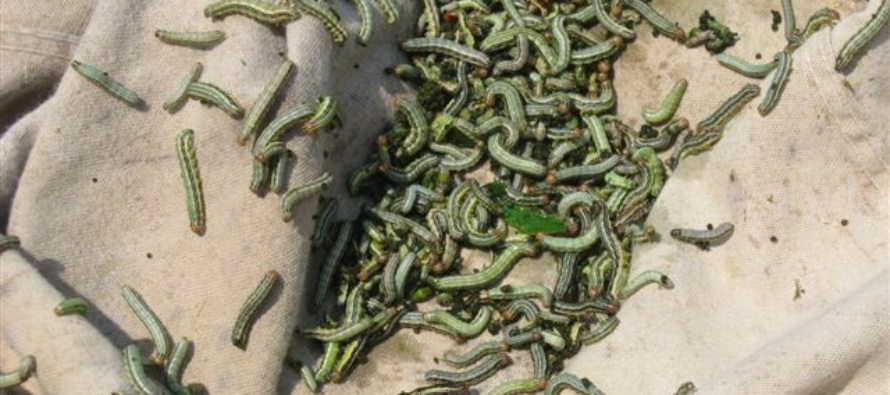Armyworms and Bollworms Becoming Widespread in Mississippi Crops

Related Articles
- 2010 Soybean And Corn Variety Trial Data 3
- Rice Variety Trial Results For 2010, Plus Rice Research Report 0
- Evaluation of Peanut Varieties in Mississippi, 2010 0
Latest Tweets
Bollworm:
We have had numerous reports of bollworm (soybean podworm corn earworm) moths being flushed and small  larvae in cotton and soybeans over the last couple weeks. This past week seemed to be the turning point in soybean. Nearly anyone with late blooming soybean seems to be reporting at least some level of bollworm. Most people I talk to are running 2-4/25 sweeps but there are some field that are well above threshold.
larvae in cotton and soybeans over the last couple weeks. This past week seemed to be the turning point in soybean. Nearly anyone with late blooming soybean seems to be reporting at least some level of bollworm. Most people I talk to are running 2-4/25 sweeps but there are some field that are well above threshold.
Over the last five years the Mid-South Entomology Working Group (Mississippi State University, University of Arkansas, Louisiana State University, and the University of Tennessee) has conducted extensive research on refining thresholds for bollworms in Mid-South soybeans. As a result of this research we were able to develop a dynamic threshold that can be modified depending on the price received for the soybeans and the price of the insecticide. In the table below it is important to remember that the control cost must have the application cost included with the cost of the insecticide. An example would be if you were getting $12 for your soybeans and applying a $10 insecticide + $5 application cost = $15, the threshold would be 5.5 larvae/25 sweeps. You may notice that we removed all pyrethroids from our control guide for bollworms in cotton and soybean. This is due to widespread tolerance and very inconsistent and poor performance over the last several years. There are folks that still want to use pyrethroids and that’s fine, but remember, the most expensive product is the one that does not work. I have had one report behind a pyrethroid spray that was about 40% control. Adding acephate does help but in the past we have seen numerous failures with the mixture of pyrethroids and acephate as well. Use at your own risk. Treatments of choice are Prevathon, Besiege, Intrepid Edge, and Belt.

Armyworms:
This is shaping up to be terrible armyworm year. Very high levels of armyworm are being found in numerous crops.  Most are coming of grasses either after completing eating all the foliage or after a herbicide application kills the grass. In most cases, these armyworms prefer to feed in the grass but when the grass is gone they will wreak havoc on soybeans and very quickly. Nearly all caterpillar pest will eat 90% of all the food they consume in their lifetime in the last 3 days as a larvae. This is why we have thresholds often that are based on worms over 1/2″ in size. Prior to 1/2′ in size, feeding is minimal time to allow so there is a few days for natural enemies and or disease to reduce population numbers. The reason armyworms coming off of grass to soybeans is so time sensitive, is because often these caterpillars are already large in size from feeding on the grass when they move over to the beans. Literally you can lose nearly all foliage in a soybean field in 3 days if numbers are high enough. What to do? Scout the grasses before applying any herbicide. Look for the white etching or window paining on key grasses such as signal grass, browntop millet, or crabgrass. Part the grass back and look on the ground for worms. If numbers are exceeding 4-5 square foot then add an insecticide with the herbicide. As long as it is the grass strain fall armyworm you can control them very good still with pyrethroids.
Most are coming of grasses either after completing eating all the foliage or after a herbicide application kills the grass. In most cases, these armyworms prefer to feed in the grass but when the grass is gone they will wreak havoc on soybeans and very quickly. Nearly all caterpillar pest will eat 90% of all the food they consume in their lifetime in the last 3 days as a larvae. This is why we have thresholds often that are based on worms over 1/2″ in size. Prior to 1/2′ in size, feeding is minimal time to allow so there is a few days for natural enemies and or disease to reduce population numbers. The reason armyworms coming off of grass to soybeans is so time sensitive, is because often these caterpillars are already large in size from feeding on the grass when they move over to the beans. Literally you can lose nearly all foliage in a soybean field in 3 days if numbers are high enough. What to do? Scout the grasses before applying any herbicide. Look for the white etching or window paining on key grasses such as signal grass, browntop millet, or crabgrass. Part the grass back and look on the ground for worms. If numbers are exceeding 4-5 square foot then add an insecticide with the herbicide. As long as it is the grass strain fall armyworm you can control them very good still with pyrethroids.




I had a problem with army worms in my multiplying onions last year and looks like I may have that problem again this year, I just harvested my onions bulbs and saw signs of the army worms getting in the stems again.